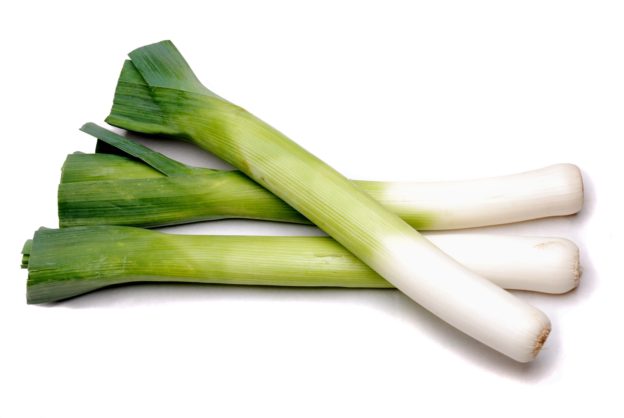Leeks are found in most grocery stores, yet some of us just don’t quite know what to do with them. I recently released a video (by viewer request!) on the basics of leeks. The video scans topics such as what they are, what they taste like, nutritional aspects, how to choose, store, preserve, and use them, as well as offering some links to interesting recipes. Below is a link to my video covering this topic. Enjoy!
Below the video is a copy of my notes used in the video discussion for your reference. Please do let me know if you need further information about leeks and I’ll be happy to provide the info if I can!
Hope all this helps!
Judi
Leeks 101 – The Basics
About Leeks
Leeks are in the same plant family as onions, scallions, garlic, shallots, and chives. They look like giant scallions (or spring onions). They have the mildest flavor of their plant family. They bring a hint of garlic and onion to dishes they’re used in. They can be eaten raw in salads or cooked.
Nutrition tidbits
With leeks being members of the allium family (like onions and garlic), they have health-promoting properties that benefit cardiovascular health, help fight cancer and other diseases prevalent in this world today.
They contain good amounts of vitamin K, manganese, copper, vitamin B6, vitamin C, folate, iron and more.
How to select
Smaller leeks will be more tender than the larger ones. Look for dark green leaves that are crisp and free of blemishes. Avoid ones with dried roots as they are older and not as fresh.
How is it usually eaten…raw or cooked?
Leeks are used in any dish where a mild onion flavor is desired. This usually involves cooking, but they can also be eaten raw anytime a mild onion flavor is preferred.
Fresh vs frozen vs canned
Leeks are commonly found fresh in grocery stores. They do not come canned and it’s unlikely to find them frozen. However, you can freeze them yourself to preserve them for later use.
To freeze fresh leeks: Wash them thoroughly to remove any grit between the layers and allow them to air dry as much as possible to remove water. Remove the outer tough layers, cut off the root end and chop the leeks into desired size pieces. Place them in a labeled freezer bag and store in the freezer. They should keep well for 5 to 6 months.
How to prepare
Leeks grow partly underground, so dirt or sand is likely to be between the layers of their leaves. Wash them thoroughly before cooking. Several methods can be used:
1. Trim off the roots and the tough, dark green tops of the leaves. If the outer layer is wilted or discolored, peel it away and discard. Slice the leek completely in half lengthwise. Separate the leaves and rinse them well under running water. The leeks can then be sliced into desired size pieces.
2. Quarter or halve the leek lengthwise, leaving the root end intact by cutting from about one inch up from the root end. Fan the stalks outward and rinse them under running water while rubbing the leaves with your fingers to remove dirt. This works well if using the leek whole in a recipe.
3. If you need sliced leeks, slice them crosswise and wash the pieces well in a bowl of water or in a colander under running water. Repeat this process until you see that all dirt has been removed.
However you choose to wash the leeks, just be sure you wash them thoroughly because there’s sure to be dirt between the layers!
Cooking/serving methods
RAW:
Add finely chopped leeks to salads.
Cooking possibilities:
Sauté leeks and fennel. Garnish with fresh lemon juice and thyme.
Make vichyssoise, a cold soup made from puréed cooked leeks and potatoes.
Add leeks to broth and stews for extra flavoring.
Braised leeks sprinkled with fennel or mustard seeds make a wonderful side dish for fish, poultry or steak.
Add sliced leeks to your favorite omelet or frittata recipe.
Leeks can be fried, braised, boiled in soups or stocks, roasted in an oven, and even caramelized like onions. When cooking, try not to overcook them, as that will make them mushy. Cook them until fork crisp/tender.
How to preserve it
Leeks will keep in a plastic bag in the refrigerator for up to 5 days.
For longer storage time, they may be frozen. Leeks do not need to be blanched when freezing. Simply wash well, chop, then place in labeled freezer bags.
Herbs/spices that go well with leeks
Leeks can be used in place of onions in any dish, imparting a mild onion flavor. Complimentary herbs include parsley, sage, thyme, basil, lemon and mustard.
Other foods that go well with
Leeks partner well with ham, chicken, cheese, cream, garlic and shallots.
Recipe links
Assorted recipes using leeks … https://www.thespruceeats.com/best-leek-recipes-4001093
Potato and Leek Casserole … https://bakeatmidnite.com/potato-leek-casserole/
More assorted recipes using leeks … https://www.bonappetit.com/recipes/slideshow/23-favorite-leek-recipes-like-onions

